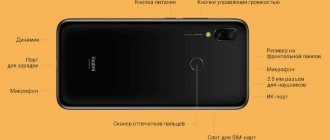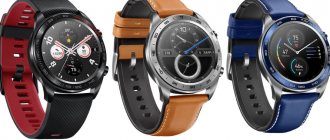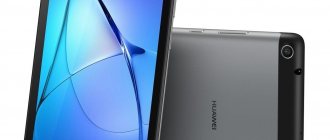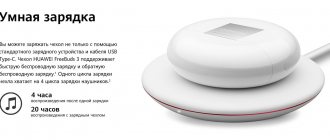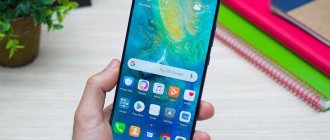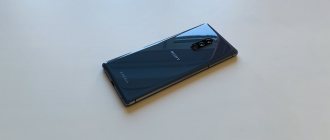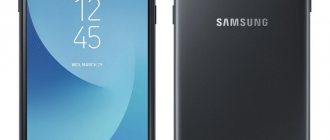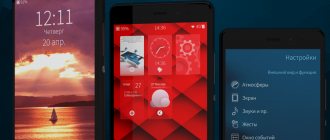Equipment
I received my sample without a kit, so we will study the accessories in absentia:
- power unit
- USB C cable
- USB-C -> 3.5 mm headphone adapter
- case
- headset with USB-C plug
The smartphone can immediately be criticized for the lack of a 3.5 mm headphone jack.
How is it usually done? They cut out the audio output and add protection from water and dust. In the case of Huawei P20, there is neither one nor the other. There is only splash protection (IP53), so you should not swim with the P20.
Compare phones - select a smartphone model
Comparison - Huawei P20 vs Huawei P smart
Huawei P20 smartphone from 2020, weighing 165 g and measuring 149.1 x 70.8 x 7.7 mm.
It is equipped with a 5.8 inch screen, 12 megapixel camera and 128 GB memory, 4 GB RAM. Its Octa-core processor (4×2.4 GHz Cortex-A73 & 4×1.8 GHz Cortex-A53) Huawei P smart smartphone from 2020, weighs 143 g and measures 150.1 x 72.1 x 7.5 mm. It is equipped with a 5.65 inch screen, 13 megapixel camera and 64 GB memory, 4 GB RAM, 32 GB, 3 GB RAM. Its Octa-core processor (4×2.36 GHz Cortex-A53 & 4×1.7 GHz Cortex-A53)
For a complete comparison of all features, view the table below.
or
| General characteristics | |||
| release date | 2018, March | 2017, December | |
| Dimensions (H x W x D) | 149.1 X 70.8 X 7.7 mm | 150.1 X 72.1 X 7.5 mm | |
| Weight | 165 g. | 143 | |
| Frame | Front and back panels made of glass, aluminum frame | Glass front panel, aluminum body | |
| Colors | Twilight, Black, Midnight Blue, Pink Gold | Black, Blue, Gold, Rose Gold | |
| Battery | 3400 mAh, Non-removable, Li-Po | 3000 mAh, Non-removable, Li-Po | |
| approximate price | 440 EUR | 170 EUR | |
| Performance and components | |||
| Operating system (OS) | Android 8.1 (Oreo), upgradable to Android 9.0 (Pie); EMUI 8.1 | Android 8.0 (Oreo); EMUI 8 | |
| Chipset | — Hisilicon Kirin 970 (10 nm) | — HiSilicon Kirin 659 (16 nm) | |
| Processor CPU | — 8 core (4×2.4 GHz Cortex-A73 + 4×1.8 GHz Cortex-A53) | - 8 core (4×2.36 GHz Cortex-A53 + 4×1.7 GHz Cortex-A53) | |
| Video processor GPU | — Mali-G72 MP12 | — Mali-T830 MP2 | |
| External memory | No | microSD, up to 256 GB (use SIM 2 slot) | |
| Inner memory | 128 GB, 4 GB RAM | 64 GB, 4 GB RAM 32 GB, 3 GB RAM | |
| Antutu 8 | 235257 | ||
| Antutu 7 | 207282 | 87123 | |
| GeekBench 5 Single Core | 191 | ||
| GeekBench 5 Multi-Core | 861 | ||
| GeekBench 4 Single Core | 1891 | 926 | |
| GeekBench 4 Multi-Core | 6712 | 3626 | |
| GeekBench 4 RenderScript | 3049 | ||
| Screen | |||
| Technology | LTPS IPS LCD | IPS LCD | |
| Touchscreen | yes, capacitive | yes, capacitive | |
| Number of colors | 16M | 16M | |
| Size (Diagonal) | 5.8″ (inches) | 5.65″ (inches) | |
| Screen area | 84.9 cm2 | 82.4 cm2 | |
| Aspect Ratio | 18.7:9 (Height:Width) | 18:9 (Height:Width) | |
| Screen/body ratio | 80.4% | 76.1% | |
| Resolution (pixels) | 1080 x 2240 px | 1080 x 2160 px | |
| Pixel Density | 429 PPI | 427 PPI | |
| Camera and video | |||
| Rear camera, basic | 12 MP, Dual camera | 13 MP, Dual camera | |
| Camera Specifications | -12 MP, f/1.8, 27mm (wide), 1/2.3", 1.55µm, OIS, PDAF & laser AF -20 MP B/W, f/1.6, 27mm (wide), 2x lossless zoom, PDAF | -13 MP, AF -2 MP, depth sensor | |
| Functions | Leica optics, LED flash, HDR, panoramas | LED flash, HDR, panoramas | |
| Video | [email protected] , [email protected] , [email protected] (gyro-EIS), [email protected] | [email protected] | |
| DxOMark Main Score | 102 | ||
| DxOMark Photo | 107 | ||
| DxOMark Video | 94 | ||
| Front camera, selfie | 24 MP, Single camera | 8 MP,Single camera | |
| Specifications | -24 MP, f/2.0 | -8 MP, f/2.0 | |
| Video | [email protected] | ||
| Communications and connections | |||
| SIM cards | Single SIM (Nano-SIM)Dual SIM (Nano-SIM, dual standby) | Single SIM (Nano-SIM)Hybrid Dual SIM (Nano-SIM, dual standby) | |
| Communication standard | GSM/HSPA/LTE | GSM/HSPA/LTE | |
| Show all network frequencies: | |||
| Frequencies | -2G - GSM 850 / 900 / 1800 / 1900 - SIM 1 & SIM 2 (dual-SIM model only) -3G - HSDPA 850 / 900 / 1900 / 2100 -4G - LTE | -2G - GSM 850 / 900 / 1800 / 1900 - SIM 1 & SIM 2 (dual-SIM model only) -3G - HSDPA 850 / 900 / 1900 / 2100 - LX1 HSDPA 850 / 900 / 1900 / 2100 / 800 - LA1 HSDPA 850 / 900 / 2100 - LX2, LX3 -4G - LTE band 1(2100), 3(1800), 7(2600), 8(900), 20(800) - LX1 LTE band 1(2100), 3(1800) ), 5(850), 7(2600), 8(900), 19(800), 20(800) - LA1 LTE band 1(2100), 3(1800), 5(850), 7(2600), 8(900), 28(700), 39(1900), 40(2300), 41(2500) - LX2, LX3 | |
| Speed | HSPA 42.2/5.76 Mbps, LTE-A (3CA) Cat16 1024/150 Mbps | HSPA 42.2/5.76 Mbps, LTE-A (2CA) Cat6 300/50 Mbps | |
| GPRS | Yes | Yes | |
| Edge | Yes | Yes | |
| WiFi | Wi-Fi 802.11 a/b/g/n/ac, dual-band, WiFi Direct, hotspot | Wi-Fi 802.11 b/g/n, WiFi Direct, hotspot | |
| GPS | Yes, with A-GPS, GLONASS, GALILEO | Yes, with A-GPS, GLONASS, BDS | |
| NFC | Yes | Yes (FIG-LX1 only) | |
| USB | 3.1, Type-C 1.0 reversible connector | microUSB 2.0 | |
| Bluetooth | 4.2, A2DP, LE, EDR, aptX HD | 4.2, A2DP, LE | |
| Music and audio | |||
| Radio | No | FM radio | |
| 3.5mm audio jack | No | Yes | |
| Another | - 32-bit/384kHz audio - Active noise cancellation with dedicated microphone | - Active noise cancellation with dedicated microphone | |
| Other Features | |||
| Sensors | — Fingerprint scanner (front panel), accelerometer, gyro, proximity sensor, compass, color spectrum | — Fingerprint scanner (rear-mounted), accelerometer, proximity sensor, compass | |
| Other Addons | — Fast battery charging — Dust and splash resistant | ||
| Versions | — Other names: Huawei Enjoy 7S for China FIG-LX1, FIG-LA1, FIG-LX2, FIG-LX3 models have single sim and dual sim versions | ||
Share Share
Design and convenience
The P series has always been famous for its compact dimensions. This is a real find for those who want a flagship device, but are not ready to put up with the spade-shaped dimensions of the phone.
You throw P20 in your front jeans pocket and no problem! Even when you get into the car, you don’t feel any discomfort. The same cannot be said about devices with a screen of 5.5 inches or more - they immediately pierce your stomach. And it is generally impossible to get such a device out of your pocket while sitting in a vehicle.
In terms of size and ease of use, Huawei P20 can be compared with the previous generation, iPhone X and Sony Xperia XZ2 Compact. Yes, our hero is the largest of them, but still in the class of compact devices. Below is a detailed comparison.
| Hidden text | SelectExpand> | ||||
| Length | Width | Thickness | Weight | ||
| Huawei P20 (5.8'') | 149,1 | 70,8 | 7,65 | 165 | |
| Huawei P10 (5.1'') | 145,3 | 69,3 | 7 | 145 | |
| iPhone 8 (4.7'') | 138,4 | 67,3 | 7,3 | 148 | |
| iPhone X (5.8'') | 143,6 | 70,9 | 7,7 | 174 | |
| Sony Xperia XZ2 Compact (5'') | 135 | 65 | 12,1 | 168 | |
The P20 feels great in the hand. The only thing that confuses me is the very slippery body. It’s easy to drop a twenty on the floor, so buying a soft and thick case is strictly necessary. Unfortunately, official cases for Huawei P20 are not sold in Russia, but they are available in the West. Here are some examples.
A protective film is applied to the screen directly from the factory. It has a mediocre oleophobic coating, but it also gets scratched quickly. Having peeled off the film, I discovered excellent oleophobic properties on the surface of the glass. In P10, surprisingly, this was not the case.
Hardware platform
Specifications of Huawei P20 Pro are 6 GB of RAM and 128 GB of storage. The company decided not to release versions with a smaller body kit. For example, you won’t be able to buy a phone that has 64 GB of storage. This approach is quite justified, considering that the Huawei P20 Pro does not support the use of memory cards.
The Huawei P20 Pro processor is a purely Chinese development, HiSilicon Kirin 970. The platform is a combination of four cores, 4-Cortex A73, 4-Cortex A53. In addition to the central one, the smartphone uses an i7 coprocessor, which is busy performing a wide variety of tasks, relieving the main computing circuit.
Important! The Huawei P20 Pro does not create any performance problems. The phone confidently copes with any task. Modern games run at maximum settings, even Modern Combat 5 with its exceptional dynamics.
In synthetic tests, the device outperforms most competitors. And this is despite the fact that the processor platform is inferior in some respects to the top-end Snapdragon 845 CPU. The operation of other hardware platform complexes is also not satisfactory. Modems for data transmission show almost maximum performance (by communication standards). Satellites are located quickly, all three main orientation systems GPS, Beidou, GLONASS are available.
Display
It looks very funny when a manufacturer tries to repeat the success of a competitor (we all know who we are talking about), but it turns out so-so.
Why make a cutout for the front camera if there is still so much space to the edge of the smartphone?
Yes, the P20 has really narrow frames on the sides, but not on the top, and certainly not on the bottom.
For example, Oppo F7 also has an island for the front camera.
Only its top frame is exactly the same narrow as the side ones. Huawei P20 cannot boast of the same.
Fortunately, in the settings you can paint over these inappropriate cutouts with a black stripe. To the left and right of the camera there will only be service information (network status, clock, battery, etc.), but the device will look much more solid. But, unfortunately, not everything is smooth here either. Third-party applications do not adapt to the “virtual” display frames - the black bar simply covers part of the interface. The moment was clearly not thought through.
Otherwise, there is nothing to complain about the display. High-quality, pleasing to the eye IPS panel with excellent viewing angles.
By the way, the brightness reserve of the smartphone is excellent. I had two smartphones on my hands at the same time: our hero and Oppo F7. So, it was much more difficult to make out anything on the display of the latter in bright sunshine. There were no such problems with the P20 - everything is clearly visible.
Smartphone impression
Of course, this smartphone has its drawbacks, like any gadget. While making a full review of the Huawei P20, we must not forget about them. Let's look at them in more detail:
- No wireless charging;
- There is no stereo sound (there is only one speaker);
- The facial recognition feature sometimes lags;
- No memory card.
Despite the above disadvantages, Huawei P20 is one of the best models in terms of price-quality ratio. It has an excellent camera, holds a charge for a long time and has many other positive qualities. To summarize, we can say that the Huawei P20 is an inexpensive gadget that has the features of the most expensive flagships. Therefore, the device can be called a worthy choice.
Specifications Huawei P20
It is logical to compare the characteristics of the P20 with the previous generation. Let's do this in a large free sign under the cut.
| Hidden text | SelectExpand> | ||
| Huawei P10 (VTR-L29) | Huawei P20 (Emily-L29) | ||
| CPU | Kirin 960 (4x Cortex A73 2.4 GHz + 4x Cortex A53 1.8 GHz, 16 nm) | Kirin 970 (4x Cortex-A73 2.36 GHz and 4x Cortex A53 1.8 GHz, 10 nm) | |
| Graphic arts | Meli-G71 MP8 | Mali-G72 MP12 | |
| RAM | 4 GB LPDDR4 | 4 GB LPDDR4X (1.75 GB available after reboot) | |
| Inner memory | 32 or 64 GB UFS 2.1 (Micro SD support available) | 128 GB UFS 2.1 (115 GB free) (memory not expandable) | |
| Display | IPS, 5.1'', 1920 x 1080 pixels, 432 ppi, Gorilla Glass 5 protective glass | IPS, 5.8'', 2244 x 1080, 428 ppi | |
| Front-camera | 8 MP (f/1.9, 6 lenses, FHD video recording) | 24 MP (FHD+ video recording) | |
| Main cameras | 20 MP (black and white sensor) + 12 MP (RGB matrix, f/2.2, 27 mm focal length, optical stabilization, 2x hybrid zoom, 4K recording) | 20 MP (monochrome sensor, f/1.6) + 12 MP (Sony IMX380 color sensor, f/1.8, matrix size 1/2.3'', pixel size 1.55 microns, 4K recording) | |
| Battery | 3,200 mAh + SuperCharge fast charging | 3,400 mAh + fast charging | |
| OS (at time of release) | Android 7.0 + EMUI 5.1 shell | Android 8.1 + EMUI 8.1 | |
| Sensors | Accelerometer, light and proximity sensors, fingerprint scanner, gyroscope, compass, Hall sensor | ||
| Connectors | USB C, 3.5mm audio output | USB C 3.1, no audio output | |
| Interfaces | LTE Cat. 12, Wi-Fi (Dual Band), 2x Nano SIM, Bluetooth 4.2, NFC, GPS, Glonass, Beidou, Galileo | LTE Cat. 18 (in theory), in practice Cat. 13, Wi-Fi (Dual Band), 2x Nano SIM, Bluetooth 4.2, NFC, GPS, Glonass, Beidou | |
| Moisture protection | No | IP53 | |
Specifications
We can talk for a long time about the technical characteristics of Huawei P20. The parameters of this smartphone model are very good:
- Android 8.1, EMUI 8.1;
- High-quality screen 5.84”, 2240×1080, 425 ppi. It has automatic brightness adjustment (brightness 400 cd/m2). The viewing aspect ratio is also good - 18.7:9 (2,074:1). LTPS IPS;
- Wi-Fi 802.11 a/b/g/n/ac (2.4/5 GHz) 4x4 MIMO, Bluetooth v4.2, USB Type-C 3.1, NFC, IR transmitter;
- The HiSilicon Kirin 970 chipset is used with 8 cores (4xCortex-A73 2.36 GHz + 4xCortex-A53 1.8 GHz) and 64 bit, 10 nm. i7 coprocessor. Graphics accelerator Mali-G72 MP12;
- Battery Li-Pol 3400 mAh. There is a fast charging function;
- Regarding Honor's characteristics in terms of memory, the Huawei Honor P20 has 4 GB of RAM (LPDDR4) and 128 GB of internal memory (UFS 2.1);
- Supports two nano-SIM cards. There is one radio module;
- To identify the user, there is a fingerprint sensor on the front panel, and the gadget can also recognize the owner using the facial recognition function. In addition, the gadget has light, proximity, acceleration sensors, a compass and even a gyroscope;
- The cameras on the smartphone are as follows. Front camera, 24 megapixels, autofocus, f/2.0. Main camera 12 megapixels (color)/20 MP (b/w) megapixels, f/1.6/1.8, OIS, LED flash, 4K video recording;
- Full dimensions of Huawei P20: 149.1 x 70.8 x 7.65 mm. Weight – 165 grams.
Performance
The findings are disappointing.
If you need games and the smoothest possible picture, without a hint of lags or slowdowns, then forget about Huawei. And our hero was no exception.
The biggest and, perhaps, the only disadvantage of the Kirin 970 processor is the Mali-G72 graphics accelerator, which in the same World of Tanks Blitz produces a frame rate of 30-50 FPS, no more.
Its competitor, the Adreno 540, which is part of the Qualcomm Snapdragon 835 processor, has no problem maintaining a maximum frame rate of 60 FPS.
Throttling is present, but insignificant. The smartphone warms up (up to a maximum of 47 degrees), but performance practically does not drop.
In all other respects, there is nothing to complain about the P20. Maximum speed in the system, in applications, and so on. Yes, in synthetic tests the Kirin 970 chipset lags behind the Qualcomm Snapdragon 845, but it’s impossible to feel this in practice. There’s no need to be silly - the Huawei processor is relevant now and will remain so for another year or two.
| Hidden text | SelectExpand> |
Who is the P20 suitable for?
Huawei P20 is an ideal option for those who are passionate about mobile photography and want one of the best cameras among all flagships. If you need an affordable flagship with good cameras, battery life and an impressive design, then the Huawei P20 is your choice.
Specifications:
- Android 8.1, EMUI 8.1
- Display 5.84”, 2240×1080, 425 ppi, automatic brightness control, LTPS IPS
- HiSilicon Kirin 970 chipset, 8 cores (4xCortex-A73 2.36 GHz + 4xCortex-A53 1.8 GHz), plus an i7 coprocessor and a Mali-G72 MP12 graphics accelerator
- 4 GB RAM (LPDDR4), 128 GB internal (UFS 2.1)
- nanoSIM, up to two cards, one radio module
- Li-Pol battery 3400 mA, fast charging
- Front camera, 24 megapixels, autofocus, f/2.0
- Main camera, 12 megapixels (color)/20 MP (b/w) megapixels, f/1.6/1.8, OIS, LED flash, 4K video recording
- Wi-Fi 802.11 a/b/g/n/ac (2.4/5GHz), USB Type-C, NFC
- GPS, GLONASS
- Fingerprint sensor (front-mounted)
- LTE cat.18
- Dimensions – 149.1 x 70.8 x 7.65 mm, weight – 165 grams
Cameras
Huawei is very proud that its camera has become smart.
Artificial intelligence works as follows. You point the sensor at the object, focus, and the algorithms immediately evaluate what is in the frame and select the optimal settings for shooting. The user does not need to think about anything. Well, it would seem.
In fact, the situation is such that it is better to turn off this “smart intelligence” once and for all.
While at the football game, I tried to remove the playing field. Immediately after focusing, the smartphone set the “Landscape” mode. The contrast has increased, the saturation has increased, but the quality and detail of the image have seriously dropped. Here are some examples.
Filmed on automatic
AI photo
As a result, a photo taken the old fashioned way (automatically, without AI) is of much better quality.
Below are the main examples of photos from the Huawei P20 camera.
Have you looked at the photo? Have you downloaded the originals (via this link)? Then let's move on to a more detailed review.
HDR
Huawei has a very strange idea of what dynamic range is. Typically, this is a bright, saturated shot with even exposure throughout the frame. Dark areas are highlighted as much as possible, and too bright areas are darkened.
No HDR
HDR mode
No HDR
With HDR
No HDR
HDR mode
Unfortunately, the Huawei P20, when HDR is activated (there is still no automatic mode), makes the picture noticeably darker and more contrasty than it should be. This is where HDR's work ends. Here are a couple of examples.
Blur background
One of the key features of any modern flagship. Our hero was no exception. Fortunately, the smartphone copes with this mission just fine. Look at the examples below.
Note that the right frame is complicated by disheveled hair. I must admit that the device processed them quite adequately. Yes, the ends of the hair went into the soap, but the main mass still remained in focus. Well done Huawei!
Zoom
The first Huawei P20 camera with 12 megapixels is equipped with a lens with a focal length of 27 mm. The second module is already 20 megapixels and is covered with glass with the same focal length. However, given that the resolution of the second camera is higher, overlaying images on top of each other gives us a conditionally optical, 2x zoom.
The thing is very useful, because you can easily bring closer an object that is located in the distance and for which there is no way to get closer. Yes, this is not the 10x hybrid zoom in the Huawei P20 Pro, however, the tool works well here too. Let's look at examples, immediately followed by 100% crops to evaluate the quality of the images.
| Hidden text | SelectExpand> |
Night
The P20 handles night shots just fine! High detail, not suppressed by noise reduction, excellent white balance, and so on.
Separately about the “Night” mode, which, as always, is excellent. By the way, this scenario is present on all devices from Huawei and distinguishes them from their competitors. For a great shot taken at Night, you will definitely need a tripod. In this mode, the automation sets a high shutter speed for 10-15 seconds, depending on the lighting level. As a result, the pictures are perfectly balanced in light, bright, almost daytime. Of course, you can’t get away with this.
Professional mode
The device can shoot in RAW (only in Pro mode) and does it very well. Here are a couple of examples of images, the first of which was shot on automatic in JPEG, and the second was developed from RAW format (.DNG in this case):
If you do a little magic when converting a photo from RAW, you can get a very interesting result:
Another example. Automatically, the bright red tulip petals merge into one mess. If you shoot in RAW, then during development you can stretch the image and colors at the same time to a higher level.
That is why I recommend that you definitely adopt the “Pro” mode. It would be a sin not to use all the capabilities of the Huawei P20 camera to the fullest.
⇡#Camera
Huawei had to set a record in something - without this, the new devices, despite their high status within the Chinese brand’s lineup, would have a hard time competing with other flagships. Still, P-series smartphones used to be noticeably cheaper than the flagships of Apple, Samsung or Sony, but now they play in approximately the same price category. And this record is, of course, the number of rear cameras. There are three of them here.
The first consists of an RGB sensor with physical dimensions of 1/1.7″ and a resolution of 40 megapixels – this is a record among current smartphones for both indicators. Only Nokia five years ago (Lumia 1050 with a 1/1.5″ sensor) could boast of something similar. However, this is not a “real” 40 megapixels - in fact, it is a 10 megapixel “Bayer” sensor with clever subpixel grouping and, probably, double exposure for each frame (and not just for those marked by the application as HDR). The resulting result exceeds in color resolution what can be obtained from a “regular” 10-megapixel sensor, but, naturally, is inferior to what a “real” 40-megapixel sensor produces (like the Sony 7R III camera, for example).
| On the left is an image with a resolution of 10 megapixels, on the right is 40 megapixels, below are enlarged fragments of images | ||
By default, the P20 Pro shoots at 10 megapixels (3648 x 2736), but you can also activate 40 megapixels (7296 x 5472) if you wish. Examples above - it’s easy to notice that with a fourfold difference in resolution, the difference in detail is not at all as striking as it could be. Or even not visible at all.
This camera is equipped with a lens with an equivalent focal length of 27 mm and an aperture of ƒ/1.8 - far from today's records, but not bad at all. But the second camera, with a 20 megapixel monochrome sensor (physical dimensions - 1/2.7″) is already equipped with optics with an ƒ/1.6 aperture. And this is much more important, since it is she who is responsible for the most part for catching light in poor lighting.
| Examples of shooting with a wide angle, 3x and 5x zoom | ||||
The third camera is solely responsible for zoom – it is an auxiliary 8-megapixel module measuring 1/4″, the lens of which has an equivalent focal length of 80 mm and an aperture of ƒ/2.4. It allows you to count on a full 3x optical zoom with a maximum resolution of 10 megapixels and a hybrid (with software “fine-tuning” of the image) 5x zoom. In short, this is the best solution of this kind that exists today in the world of mobile cameras, and even by a large margin from the rest. Examples of pictures using zoom can be seen above.
| Examples of shooting with a wide angle, 3x, 5x, 10x zoom | ||||
You can also activate 10x zoom - in this case, the loss in quality will be obvious, but it is quite possible to shoot in this mode.
The camera works with an optical stabilization system - also one of the most effective among solutions of this kind. Huawei's words about 6 axes of stabilization, alas, look like just another marketing technique, and not the smartest one, but they do not affect the camera's capabilities - I was able to take a sharp image handheld with a shutter speed of up to 1/6 (in this case, however, I had to use my elbows rest against something). For a smartphone this is top class. Given its high aperture and the use of a monochrome sensor, which allows you to get more detail in low light and expand the dynamic range of the final image, the P20 Pro can easily be considered a leader in terms of low-light shooting.
An example of shooting with a multi-frame exposure and a “four-second” shutter speed
Especially if you shoot some static scenes and activate the multi-frame exposure mode - in this case, a shutter speed of 4 seconds will even be written in EXIF. This is factually a lie, but the user should not worry about this - the picture looks amazing.
The camera uses hybrid autofocus - the phase method is combined here with contrast when using a laser rangefinder. There are no complaints about the focusing system.
| Huawei P20 Pro, camera app interface | ||
The interface of the camera application is the same as that of the Mate 10 Pro: the fonts are in place, and different menus can be called up by swiping sideways on the screen, and special color schemes (bright, normal and faded).
An important point regarding the “intelligent” capabilities of the camera is that it constantly tries to determine the situation or object in the frame (from a pet to weather conditions) and adapt the settings for the highest quality shooting at that moment. The P20 Pro detects objects really vigorously, but with the settings everything is not always great - the software turns cats, already cute, into some completely radically smoothed out “cutes”. The same thing happens when shooting regular portraits, and in general - a person in this regard is still smarter than a machine, and the P20 Pro has a mode with manual settings, a virtual horizon (why is it not available in standard mode?) and the ability to shoot in RAW format. So, here you can turn off this overly annoying AI - while in the Mate 10 Pro this could not be done. Let's rejoice.
| Left – picture without HDR, right – with activated HDR | ||
HDR mode is not activated by default, it must be turned on separately, and this is logical - the P20 Pro camera has an excellent dynamic range reserve, constant use of HDR is not necessary.
What’s relatively new is the software system for “light placement” when shooting a portrait - it’s not always appropriate and looks more like a kind of toy and entertainment rather than a real tool, but why not. This system works with both the main module and the front one. Naturally, there is also a traditional software background blur mode with the ability to change the “aperture” after the fact in a virtual range from ƒ/0.95 to ƒ/16.
You can also activate black and white shooting - it’s worth saying that the image processing algorithms are well tuned, in this mode the picture looks truly purebred. In general, the picture produced by the Huawei P20 Pro camera is almost perfect by phone standards – at least at the current stage of development of mobile cameras. Yes, you can find fault with the detailing or edge distortion in photographs without zoom, but this is really a very good level: both in terms of dynamic range and contour sharpness (without “Samsung” excesses). And I already wrote above about the P20 Pro’s ability to shoot in the dark. There is a lot to dislike about DxO Mark, and you shouldn’t blindly trust their estimates, but in this case they are not far from the truth - based on all the parameters, Huawei has the best mobile camera to date.
Huawei P20 Pro: gallery
View all images (25)The smartphone can shoot video with a resolution of up to 3840 × 2160 with a frequency of up to 30 frames per second and stabilization, as well as slow-motion video (with a frequency of 960 frames per second) with a resolution of 1280 × 720. Huawei keeps up with fashion here too. Stabilization is available only when shooting at a maximum resolution of 1920 × 1080 at a frequency of 30 frames per second - these are the parameters that are set by default.
Example of video shooting in 4K resolution
Example of slow motion video
The front camera in the Huawei P20 Pro is also extraordinary - 24 megapixels, a lens with an aperture of ƒ/2.0. But there is no autofocus or flash (except for the on-screen one). The focusing distance, however, is chosen correctly, the picture turns out good - both in ideal lighting and in relatively poor lighting. There are software improvements for selfies that are mandatory for Chinese smartphones - smoothing and whitening the skin, changing the shape of the face, and so on.
Front-camera
Thanks to the wild resolution of 24 megapixels, the detail in self-portraits is incredible. See for yourself.
Of course, there is a mode for skin retouching, background blur, and even all this works quite well. However, not a single smartphone has yet managed to reach the level of Google Pixel 2 XL. And P20 was no exception.
Video recording
The device can shoot 4K videos and it does it quite well. It won’t be able to compete with the iPhone X and Google Pixel 2, but it shoots decently among other competitors.
Image stabilization (digital only) works perfectly, but only when recording Full HD and 30 frames per second. If you set the frequency to 60 fps, then stabilization will no longer work.
Like the Samsung S9, our hero learned how to shoot Slow Motion video at 960 fps. The quality is quite good, but the resolution suffers. It is only 1280 by 720 pixels. Sony Xperia XZ2 can shoot the same thing at Full HD resolution.
Photo modes
I have already touched a little on the modes that the camera offers. In this section I would like to talk in more detail about most of them and show photographs.
In almost all modes, you can select the film type “Normal”, “Bright”, “Faded”.
Huawei P20 Pro, Regular film. © Photar.ru
Huawei P20 Pro, Bright film. © Photar.ru Huawei P20 Pro, Faded film. © Photar.ru
Photo mode
The main operating mode for many will of course be “Photo”. If you don’t want to “bother” at all, then this mode is created for you :) The phone is able to determine the scene and suggest a scenario. So, for example, if you are shooting grass or trees, then the AI will offer the “Green” scenario, and if the sky, then “Sky”. If it is a portrait, then the background will be blurred, and the script will be called “Portrait”, etc.
Huawei P20 Pro, shutter speed 1/895s, ISO100, f/1.8, 27mm equiv. focal length. “Photo” mode, 10MP. © Photar.ru
Huawei P20 Pro, shutter speed 1/1600s, ISO50, f/1.8, 27mm equiv. focal length. “Photo” mode, 40MP. © Photar.ru Huawei P20 Pro, shutter speed 1/50s, ISO80, f/1.8, 27mm equiv. focal length. “Photo” mode, 40MP. © Photar.ru
Huawei P20 Pro, shutter speed 1/900s, ISO100, f/1.8, 27mm equiv. focal length. “Photo” mode, 40MP. © Photar.ru
Huawei P20 Pro, shutter speed 1/895s, ISO320, f/1.8, 27mm equiv. focal length. “Photo” mode, 10MP. © Photar.ru
Huawei P20 Pro, shutter speed 1/270s, ISO50, f/2.4, 81mm equiv. focal length. “Photo” mode, 10MP. © Photar.ru
When the AI selects a scenario, it informs about this on the screen; if desired, you can disable the proposed scenario by clicking on the cross. Why might this be needed? For example, here are two pictures, in the first the AI made a mistake, in the second I turned off the proposed script and the photo turned out better.
Huawei P20 Pro, Photo mode, AI enabled. Computers make mistakes too;) © Photar.ru
Huawei P20 Pro, Photo mode with AI disabled. © Photar.ru
The artificial intelligence module is capable of offering more than 500 scenarios and recognizing 19 scenes. If a script is selected, the film type cannot be changed.
Some scripts have a more advanced option. For example, like for the “Food” scene. There is a separate mode called “Delicious food”. I didn’t notice any difference in the “Photo” mode with the “Food” scenario and the “Tasty Food” mode. The food looks “delicious” both here and there. Maybe you can do it:
For example, like for the “Food” scene. There is a separate mode called “Delicious food”. I didn’t notice any difference in the “Photo” mode with the “Food” scenario and the “Tasty Food” mode. The food looks “delicious” both here and there. Maybe you can do it:
“Delicious food” mode. © Photar.ru
“Photo” mode, “Food” scenario. © Photar.ru
Pro mode
Here you can manually adjust ISO, shutter speed, set exposure compensation and white balance. And, as I already said, only in this mode is it possible to save files in RAW format. Well, why not a Pro, right?)
When working in 10MP resolution or any other lower resolution with the “Save RAW” option selected, the phone will save a jpg file in the selected resolution and a RAW file with a resolution of 40MP into memory; by the way, the weight of such a file is as much as 79.9 megabytes. So even 128GB of internal memory, which is a lot, can run out very quickly. When saving in RAW, the user does not have access to zoom.
On the issue of working with RAW. Yes, the camera saves 40-megapixel raw files and you can actually use a RAW editor. Shadows, highlights, exposure are all editable; you can increase the exposure to more or less 2-3 stops before noise appears, which is a very good indicator for this matrix size. But let’s see with our own eyes what kind of work the AI does and understand whether it’s worth bothering with RAW editing at all. Let’s compare the “raw” file without processing with the result of AI processing.
Huawei P20 Pro, shutter speed 1/2000s, ISO50, f/1.8, 27mm equiv. focal length. "Pro" mode. The first is RAW without processing (Source), the second is with AI processing (Source). © Photar.ru
Huawei P20 Pro, shutter speed 1/2430s, ISO50, f/1.8, 27mm equiv. focal length. "Pro" mode. The first is RAW without processing (Source), the second is with AI processing (Source). © Photar.ru
As you can see, AI corrects not only colors, stretches shadows and highlights, but also corrects geometric distortions and vignetting. In most cases, achieving better results by manually editing RAW will be difficult and time consuming.
“Pro” or “Photo”?
If you compare the Photo modes and the Pro mode, it is obvious that the first one often takes better-looking photos. In the “Photo” mode, the colors are saturated, but the photos do not always win in terms of dynamic range, and sometimes even the colors are too much, so to speak, oversaturation.
Portrait mode
Portrait mode is probably the most advertised feature by Huawei marketers. Indeed, in addition to simulating various types of lighting (soft flash, butterfly flash, split flash, staged lighting, normal flash), the camera is able to very quickly recognize and focus on faces, as well as beautifully blur the background.
Huawei P20 Pro, shutter speed 1/255s, ISO50, f/2.4, 81mm equiv. focal length. Portrait mode. (Source) © Photar.ru
Huawei P20 Pro, shutter speed 1/1250s, ISO50, f/2.4, 81mm equiv. focal length. Portrait mode. (Source) © Photar.ru
Huawei P20 Pro, shutter speed 1/815s, ISO50, f/2.4, 81mm equiv. focal length. Portrait mode. (Source) © Photar.ru
Huawei P20 Pro, shutter speed 1/235s, ISO50, f/2.4, 81mm equiv. focal length. Portrait mode. (Source) © Photar.ru
Combined with a 3x or 5x zoom, you can create very interesting portraits of people on the street without invading their personal space. At 3x zoom you can get portraits with an equivalent focal length of 81mm, which is very close to the 85mm favored by portrait photographers. Among other things, you can adjust the degree of the effect on a scale from 1 to 10 and enable/disable background blur.
I note that the pictures are not always of good quality. In the process of “blurring” the background, sometimes the subject you are shooting will end up with very ugly torn edges.
Huawei P20 Pro, shutter speed 1/1055s, ISO50, f/2.4, 81mm equiv. focal length. Portrait mode. (Source) © Photar.ru
Aperture mode
In this mode, you can blur the background by adjusting the aperture values from 0.95 to 16; of course, all this happens at the software level; there is no variable aperture in the lenses. Pictures taken in this mode can later be changed - the degree of blur and even the focus point.
f/0.95
Huawei P20 Pro, shutter speed 1/110s, ISO50, f/0.95, 27mm equiv. focal length. Aperture mode. © Photar.ru
f/16
Huawei P20 Pro, shutter speed 1/115s, ISO50, f/16, 27mm equiv. focal length. Aperture mode. © Photar.ru
If you compare the background blur in "Aperture" with the simple "Photo" mode. Then I would choose “Photo”, it produces a more natural and beautiful bokeh. Here is one example for comparison, judge for yourself.
"Diaphragm":
Huawei P20 Pro, shutter speed 1/1300s, ISO50, f/0.95, 27mm equiv. focal length. Aperture mode. © Photar.ru
"Photo":
Huawei P20 Pro, shutter speed 1/1180s, ISO50, f/1.8, 27mm equiv. focal length. Photo mode. © Photar.ru
Night mode
The full power of the Leica Vario-Summilux-H1 F1.6-2.4 27-80mm ASPH system is revealed in this mode. And it really surprises! The camera is capable of creating images in the evening with incredible detail, and shooting can be done handheld, and the shutter speed sometimes reaches 6 seconds.
Huawei P20 Pro, shutter speed 4s, ISO400, f/1.8, 27mm equiv. focal length. Night mode. © Photar.ru
Huawei P20 Pro, shutter speed 1s, ISO1250, f/1.8, 27mm equiv. focal length. Night mode. © Photar.ru
Such results are obtained not only due to high ISO. The camera processes the dark areas of the frame, while at the same time the light areas (lanterns or headlights) are not overexposed. Usually, with a long shutter speed, especially when shooting handheld, a “stir” appears; if cars pass in the frame, they will be blurred. In this mode, there is no such blur, the system fixes objects in place, including headlights, lanterns, and even if there is a strong tremor in the hands, the stabilizer completely neutralizes this.
Below, for the sake of experiment, are photos in “Night” and “Pro” modes with a shutter speed of 10 seconds (the smartphone is mounted on a tripod).
"Night":
Huawei P20 Pro, shutter speed 4s, ISO2000, f/1.8, 27mm equiv. focal length. Night mode. © Photar.ru
"Pro":
Huawei P20 Pro, shutter speed 10s, ISO50, f/1.8, 27mm equiv. focal length. "Pro" mode. © Photar.ru
Night mode can be used not only at night or in the dark. Very unexpected effects are created in non-standard situations for this mode. For example, in bright backlight you can get a very interesting result.
Huawei P20 Pro, shutter speed 3s, ISO50, f/1.8, 27mm equiv. focal length. Night mode. © Photar.ru
Huawei P20 Pro, shutter speed 3s, ISO50, f/1.8, 27mm equiv. focal length. Night mode. © Photar.ru
"Monochrome"
I liked this mode the most, especially for creating portraits. It has three operating modes: Normal, Aperture, Portrait and Pro. The familiar names for monochrome modes work just like their color counterparts. When I showed the results of the zoom for the “monochrome” mode above, I said that the resolution of this mode is 20 megapixels. In addition, there is no option to save files in RAW format.
Huawei P20 Pro, shutter speed 1/345s, ISO50, f/1.6, 81mm equiv. focal length. Monochrome mode. © Photar.ru Huawei P20 Pro, shutter speed 1/2390s, ISO50, f/1.6, 27mm equiv. focal length. Monochrome mode. © Photar.ru
Huawei P20 Pro, shutter speed 1/780s, ISO50, f/1.6, 81mm equiv. focal length. Monochrome mode. © Photar.ru
Huawei P20 Pro, shutter speed 1/695s, ISO50, f/1.6, 27mm equiv. focal length. Monochrome mode. © Photar.ru
Huawei P20 Pro, shutter speed 1/6750s, ISO50, f/1.6, 81mm equiv. focal length. Monochrome mode. © Photar.ru
Huawei P20 Pro, shutter speed 1/1840s, ISO50, f/1.6, 81mm equiv. focal length. Monochrome mode. © Photar.ru Huawei P20 Pro, shutter speed 1/2190s, ISO50, f/1.6, 27mm equiv. focal length. Monochrome mode. © Photar.ru
Huawei P20 Pro, shutter speed 1/2290s, ISO50, f/1.6, 27mm equiv. focal length. Monochrome mode. © Photar.ru
Huawei P20 Pro, shutter speed 1/3130s, ISO50, f/1.6, 81mm equiv. focal length. Monochrome mode. © Photar.ru
Video
And of course the camera is capable of recording video;) There are 5 different resolutions. Highest 4K. But the stabilizer will not work in it.
FHD+ video with a resolution of 2160x1080 will already have stabilization; by the way, the stabilizer works very effectively. I suspect that there is a combination of optical stabilization and accelerometer here.
FHD 1920x1080 video at 60 frames per second is recorded without stabilization, and FHD 1920x1080 at standard frame rate and HD video (1280x720) with stabilization.
In all resolutions, you can use zooming during recording, but unfortunately, zooming does not work very smoothly, so the result is, to put it mildly, not very good.
Another very interesting video mode, which is a separate item in the “More” menu - “Slowdown”. In this mode, you can record slow-motion video at a frequency of 120 frames per second, 240 frames and 960(!) frames per second, respectively, 4, 8 and 32 times slow-motion.
In videos at 120 and 240 frames per second, you can choose which part of the video to slow down after shooting. But the most interesting feature is the video with a frequency of 960 frames per second. After pressing the record button, the smartphone creates a 10-second long video - with 2 seconds of normal speed at the beginning and end, and 6 seconds of super slow-motion video inside.
Software
During all the time I used it, I caught only one glitch. At some point, when installing another application from Google Play, the phone began to slow down terribly and did not respond to presses. I pressed the touch button twenty times and nothing happened. Even the vibration didn't work. After 10 seconds, the device vibrated convulsively, working out the missed presses. The problem was cured by rebooting the device and, fortunately, did not happen again.
In all other respects, there are no complaints about the MIUI 8.1 shell. It is still a powerful, functional and highly customizable system. The impression is slightly spoiled only by the design of the icons and the lack of normal, minimalist themes in the catalog, but this is a matter of taste. Many people use the shell from Huawei and don’t give a damn.
Sound
The device boasts only one external speaker - there is no stereo here.
However, the quality of the speaker is very high. And the smartphone is loud - your average one.
If we compare it with its competitors, the Huawei P20 can be placed in the top five devices in terms of speaker quality. The undisputed leader in this regard is the iPhone X and Samsung S9+ in second place. There are no options here.
Battery
Unfortunately, Huawei P20 could not please with decent autonomy. If you use the device to its fullest extent (Internet, music, cameras, a bunch of instant messengers and other network applications), then the device will be completely discharged by midnight.
Sometimes my P20 survived until the morning, but with 20% charge remaining. It’s clearly not worth leaving the house with such a battery.
The SuperCharge fast charging partly helps. In half an hour the battery can reach about 60%. Fully charging Huawei P20 takes an hour or twenty. Just right for the frantic pace of modern life.
